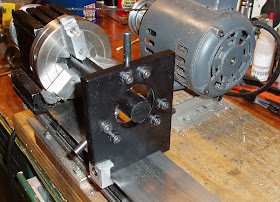I found a couple other springs in my parts box. The first is 0.946" OD with a wire diameter of 0.156". The second option is 0.943" OD with a 0.137" diameter wire. Both are 9" OAL--exactly the same length as the stock HW spring.
I'm not sure which spring to use. The first spring option might be more powerful, but the second option is lighter and may accelerate the piston faster. I'll try the second, lighter wire spring first. If it doesn't work out, I'll only have to reduce the diameter of the spring guide to fit a different spring.
First, I need that new spring guide.

Chucked a piece of delrin in the 3-jaw and the steady rest.

Faced the end off.

Rollers on the steady rest. Lot of overhang. The rest helps keep the work from deflecting.

Spotted with a center drill

The delrin machines well.

Drilled through with successively larger drill bits finally ending with a 25/64". The piston rod just fits through the hole.

Turned down the OD of the guide to 0.663"

Lathe power off. Test fit the spring on the guide. Snug, but not a struggle to install. Left a wide flange at one end of the guide. The base flange is 0.752" diameter and 0.139" thick.

Scrounged a big chunk-o-scrap steel to make a custom washer for the base of the spring guide. After facing it off, I cut a slice about 0.25" thick.

Reversed the jaws in the 3-jaw chuck and grabbed the outer edge of the washer. Faced, spotted, drilled.

Sorry, it's blurry. Used a small boring bar to bring the center hole to about 0.666". The spring guide just fits through the hole. I made some relief cuts to recess the flange at the bottom of the guide as well as recess the front of the washer inside the piston.

Piston, mainspring, and the 2 piece guide. The guide ended up at 4.175" long OAL. Pretty much the max that will fit into the 35 E piston. Full spring support = no more kinked springs.

The most current Weihrauch spring guides are made much the same way--delrin with a substantial steel washer.

I was concerned that the base washer was too thick and wouldn't allow enough of the piston rod to protrude. If that happens, the trigger can't reach the notch and the gun won't cock.

The beveled edge on the washer fits inside the piston body. It's now only a few hundredths thicker than the stock spring guide. Test fitting looks promising. The washer is 1.172" OD and 0.193" thick. The leading edge was turned down to 1.012" to fit into the rear of the piston to a depth of 0.053". The rear of the piston has a slightly beveled inside edge and I made a slight taper to the washer. The end of the piston and the top of the base washer should now self-align when the gun is cocked.

The bottom of the washer is countersunk for the end of the delrin guide. The mainspring will push against the steel base--which in turn is directly supported by the massive steel end cap. The delrin guide has good lubricity both to the spring and to the piston rod.
I still have no idea if this spring is a good choice. Every choice seems to compromise something else. I think that the gun would benefit from a lighter piston, but I'm afraid to just start milling slots to reduce the weight as there's concern that a lighter weight piston will tend to bounce at the end of the compression stroke... Don't let anybody tell you that tuning a spring gun is simple. I want this gun to go "thunk", have no vibration, and deliver an RWS hobby in the 730+ fps range. As always, I'm willing to compromise some speed for mechanical smoothness.
Need to reassemble it and set up the chrony next.




































